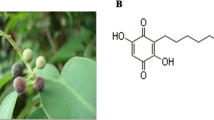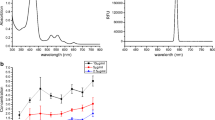Abstract
The aim of this study was to investigate the mechanism of cell death by photodynamic therapy (PDT) in the gastric cancer cell line MKN45 with focus on the mechanism of apoptosis. Gastric cancer cells (MKN45) were incubated with Photofrin for up to 24 h before exposure to He-Cd laser (441 nm, 1 J/cm2). Cell viability was assessed by the methyl-tetra-zolium assay after exposure to light. A 95% cell death (LD95) was measured with 10 μg/ml of Photofrin. DNA ladder formation and chromatin condensation were seen within 60 min. Caspase-3–like and caspase-9–like activities increased from 15 min after exposure to light. Reduction of rhodamine 123 uptake started at 30 min. Caspase-inhibitor VAD-fmk (10 mM) inhibited apoptosis, but did not influence cell viability. In conclusion, Photofrin-mediated PDT in the gastric cancer cell line MKN45 induces apoptosis within 60 min, and mitochondrial damage is likely as the first event of apoptosis.









Similar content being viewed by others
References
Dougherty TJ, Gomer CJ, Henderson BW, Jori G, Kessel D, Korbelik M, Moan J, Peng Q (1998) Photodynamic therapy. J Natl Cancer Inst 90:889–905
Ahmad N, Mukhtar H (2000) Mechanism of photodynamic therapy-induced cell death. Methods Enzymol 319:342–358
Pass HI (1993) Photodynamic therapy in oncology: mechanisms and clinical use. J Natl Cancer Inst 85:443–456
Oleinick NL, Evans HH (1998) The photobiology of photodynamic therapy: cellular targets and mechanisms. Radiat Res 150:S146–S156
Peng Q, Moan J, Nesland JM (1996) Correlation of subcellular and intratumoral photosensitizer localization with ultrastructural features after photodynamic therapy. Ultrastruct Pathol 20:109–129
Weishaupt K, Gomer CJ, Dougherty TJ (1976) Identification of singlet oxygen as the cytotoxitic agent in photo-inactivation of a murine tumor. Cancer Res 36:2326–2329
Tappeiner H, Jodlbauer A (1904) Über die Wirkung der photodynamischen (fluorescierenden) Stoffe auf Protozoen und Enzyme. Deutsches Arch Klin Med 39:427–487
Agarwal ML, Clay ME, Harvey EJ, Evans HH, Antunez AR, Oleinick N (1991) Photodynamic therapy induces rapid cell death by apoptosis in L5178Y mouse lymphoma cells. Cancer Res 51: 5993–5996
He XY, Sikes RA, Thomsen S, Chung LW, Jacques SL (1994) Photodynamic therapy with photofrin II induces programmed cell death in carcinoma cell lines. Photochem Photobiol 59:468–473
He J, Whitacre CM, Xue LY, Berger NA, Oleinick NL (1998) Protease activation and cleavage of poly (ADP-ribose) polymerase: an integral part of apoptosis in response to photodynamic treatment. Cancer Res 58:940–946
Granville DJ, Carthy CM, Jiang H, Shore GC, McManus BM, Hunt DW (1998) Rapid cytochrome c release, activation of caspases 3, 6, 7 and 8 followed by Bap31 cleavage in HeLa cells treated with photodynamic therapy. FEBS Lett 437:5–10
Tajiri H, Hayakawa A, Matsumoto Y, Yokoyama I, Yoshida S (1998) Changes in intracellular Ca2+ concentrations related to PDT-induced apoptosis in photosensitized human cancer cells. Cancer Lett 128:205–210
Separovic D, Jin He, Oleinick NL (1997) Ceramide generation in response to photodynamic treatment of L5178Y mouse lymphoma cells. Cancer Res 57:1717–1721
Laukka MA, Wang KK, Bobber JA (1994) Apoptosis occurs in lymphoma cells but not in hepatoma cells following ionizing radiation and photodynamic therapy. Dig Dis Sci 39:2467–2475
Noodt BB, Berg K, Stokke T, Peng Q, Nesland JM (1996) Apoptosis and necrosis induced with lights and 5-amoinolaevulinic acid-derived protoporphyrin IX. Br J Cancer 74:22–29
Mimura S, Ichii M, Imanishi K, Otani T, Okuda S (1988) Indications for and limitations of HpD photodynamic therapy for esophageal cancer and gastric cancer (in Japanese). Jpn J Cancer Chemother 15:1440–1444
Fisher MR, Danenberg K, Banerjee D, Bertino J, Danenberg P, Gomer CJ (1997) Increased photosensitivity in HL60 cells expressing wild-type p53. Photochem Photobiol 66:265–270
He J, Agarwal ML, Larkin HE, Friedman LR, Xue LY, Oleinick NL (1996) The induction of partial resistance to photodynamic therapy by the proto oncogene BCL-2. Photochem Photobiol 64:845–852
Granville DJ, Jiang H, An MT, Levy JG, McManus BM, Hunt DW (1999) Bcl-2 overexpression blocks caspase activation and downstream apoptotic events instigated by photodynamic therapy. Br J Cancer 79:95–100
Granville DJ, Jiang H, An MT, Levy JG, McManus BM, Hunt D (1998) Overexpression of Bcl-XL prevents caspase-3-mediated activation of DNA fragmentation factor (DFF) produced by treatment with the photochemotherapeautic agent BPD-MA. FEBS Lett 422:151–154
Ahmad N, Denise KF, Agarwal R, Mukhtar H (1998) Photodynamic therapy results in induction of WAF1/CIP1/P21 leading to cell cycle arrest and apoptosis. Proc Natl Acad Sci U S A 5:6977–6982
Suzuki H, Seto, Mori M, Suzuki M, Miura S, Ishii H (1998) Monochloramine induced DNA fragmentation in gastric cell line MKN45. Am J Physiol 275:712–716
Kessel D, Luo Y (1999) Photodynamic therapy: a mitochondrial inducer of apoptosis. Cell Death Differ 6:28
Varnes ME, Chiu SM, Xue LY, Oleinick NL (1999) Photodynamic therapy-induced apoptosis in lymphoma cells: translocation of cytochrome c causes inhibition of respiration as well as caspase activation. Biochem Biophys Res Commun 255:673–679
Oleinick NL, Morris RL, Belichenko I (2002) The role of apoptosis in response to photodynamic therapy: what, where, why, and how. Photochem Photobiol Sci 1:1–21
Author information
Authors and Affiliations
Corresponding author
Rights and permissions
About this article
Cite this article
Takahira, K., Sano, M., Arai, H. et al. Apoptosis of gastric cancer cell line MKN45 by photodynamic treatment with Photofrin. Lasers Med Sci 19, 89–94 (2004). https://doi.org/10.1007/s10103-004-0297-7
Received:
Accepted:
Published:
Issue Date:
DOI: https://doi.org/10.1007/s10103-004-0297-7




